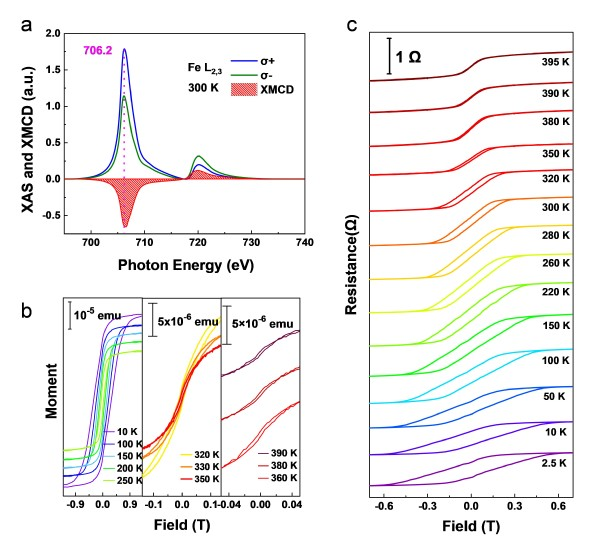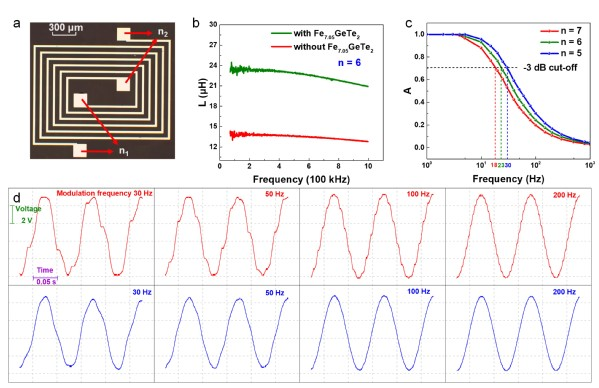Our group has made significant progress in the research of low-pass filters based on two-dimensional ferromagnetic materials. On March 20th, the relevant research findings were published online in the journal Nature Electronics (DOI: 10.1038/s41928-023-00941-z) under the title of “Low-pass filters based on van der Waals ferromagnets”. The first unit of the paper is the Department of Physics at Fudan University, and the corresponding author is Professor Faxian Xiu. Zihan Li, a doctoral student in our group, is the first author, and postdoctoral Shanshan Liu is the co author.
In recent years, two-dimensional materials have become an important carrier for studying nanomechanical systems due to their unique low dimensional mechanical flexibility and adjustable electrical properties. Among them, van der Waals layered ferromagnetic materials, as a promising new type of low dimensional material, have significant advantages in reducing device size and increasing device power. However, although two-dimensional ferromagnetic materials have been developed for several years, there are many challenges in the research of nanomechanical devices based on two-dimensional ferromagnetism. On the one hand, ordinary two-dimensional ferromagnetic materials cannot be prepared on a large scale, and on the other hand, their Curie temperature is much lower than room temperature, which does not match the preparation and working conditions of most nano electromechanical devices.
In order to construct nano-electromechanical devices based on two-dimensional ferromagnetic materials, we first successfully prepared a wafer level two-dimensional ferromagnetic material, Fe5GeTe2, using molecular beam epitaxy growth method. Iron germanium tellurium itself has a Curie temperature close to room temperature (280 K), making it a good carrier for studying two-dimensional ferromagnetic material devices. In addition, during the preparation process, we also utilized the method of element doping to regulate magnetism, epitaxial growth of a series of Fe5+xGeTe2 samples with adjustable iron component, and successfully raised the Curie temperature of the samples to 380K. The stable room temperature ferromagnetic state in the sample has also been comprehensively characterized through various methods such as electrical transport measurement, magnetization measurement, and X-ray magnetic circular dichroism measurement.

Figure1. (a) X-ray magnetic circular dichroism measurement. (b) Magnetization measurement. (c) Electrical transport measurement
On the basis of successfully preparing wafer level room temperature two-dimensional ferromagnetic thin films, we constructed a planar inductor with a few layers of iron germanium tellurium as the magnetic core. A planar inductor is a nano electromechanical device that utilizes ultra large scale integrated nanomanufacturing technology. The new planar inductor based on two-dimensional ferromagnetic materials greatly reduces the thickness and volume of the device compared to traditional planar inductors, while still exhibiting relatively good device performance. In the experiment, it was found that iron germanium tellurium played a crucial role as a magnetic core in the device: devices with iron germanium tellurium magnetic cores improved their inductance performance by 74% compared to devices without magnetic cores. Based on high-performance two-dimensional ferromagnetic planar inductors, we further constructed a series of Butterworth low-pass filters. This low-pass filter has an attenuation effect on signals above the cutoff frequency, and only low-frequency signals can pass through the filtering device. By switching different coil turns, we has achieved for the first time a low-pass filter with adjustable cutoff frequency and a dynamic range of up to 40dB. As shown in Figure 2 (d), using a two-dimensional ferromagnetic low-pass filter can generate good filtering effects for clutter signals with frequencies up to 100Hz and 200Hz.

Figure2. (a) Schematic diagram of planar inductor. (b) Performance comparison of planar inductors with and without iron germanium tellurium magnetic cores. (c) Spectral response spectrum of two-dimensional ferromagnetic low-pass filter gain. (d) Filtering of signals with different frequencies
This work fills the gap in the research of room temperature two-dimensional ferromagnetic nanomechanical devices and takes an important step from epitaxial preparation to practical application of room temperature two-dimensional ferromagnetic materials. In addition, this nano-thickness nano-electromechanical device also provides more design ideas and architectural space for constructing new electronic devices.
Paper link: https://www.nature.com/articles/s41928-023-00941-z